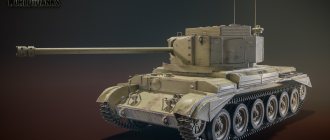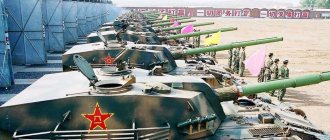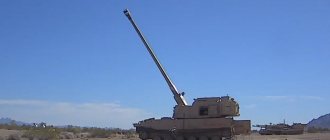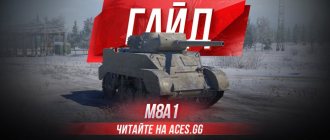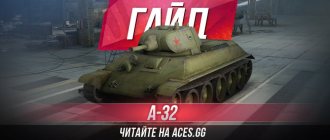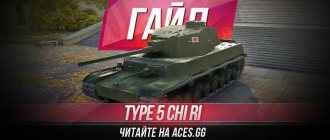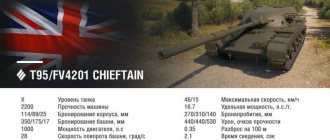Wildman
October 15, 2015
9062
0
No one doubted that very soon new Japanese tanks would come to the virtual battlefields, since their branch was incomplete, there were very few of them, and they were a young squad in this game.
And when the developers announced the release of new tanks, practically no one was surprised, but when they were shown on video, many began to get scared and think seriously about them, since this time the developers provided us with an exclusive item, which, although it has the same characteristics and game process, but not without a personal twist.
This time the developers introduced 7 combat vehicles , which turned out to be huge, powerful and interesting. It is worth considering each combat vehicle separately so that you can decide in advance on the best and most sophisticated options for Japanese power.
Type 95 (tier IV) - new “turtle”
Type 95 is the very first representative of the Japanese branch of heavy tanks. It immediately amazes with its size, but does not at all inspire positivity in its technical characteristics.
It has a powerful weapon and an interesting rate of fire, however, it is not at all pleasing with its armor, which in the thickest places reaches only 50 mm. In addition, you should not expect positive aspects in its maneuverability, which, combined with its low speed, will not particularly allow you to turn around on the battlefield and will force you to act according to one scenario and only one choice.
British tank destroyer FV4005 Stage 2
The famous "babaha" or "one-shot", a British tier 10 tank destroyer.
The tank was a consequence of the arms race during the Cold War, development was carried out from 1950 to 1957. It was supposed to become a worthy competitor to the Soviet IS-3.
However, only 2 copies were produced, which showed very weak characteristics.
Please note: The game that could. Part 1.
When firing, the vehicle was unstable, and weak armor did not save the crew even from machine guns. Therefore, the development of such huge tanks was soon abandoned.
OI Experimental (level V) – the first representative of mammoths
OI Experimental is the first Japanese tank, which in its entirety shows how huge a combat vehicle can be. It is slightly smaller in size than the German Maus tank, but it is only at the fifth level. Such huge dimensions are rarely seen in battles at these levels, so it will be quite interesting to meet such a massive enemy or ally.
If we consider the technical components, here again, contrary to all dreams, we find poor maneuverability and speed. Considering such huge dimensions of the tank, it is very difficult to imagine that it would spin like a spinning top. It is also worth paying attention to the speed, which fluctuates around 20 km/h.
Slowness is the worst side of a machine, especially such a huge one. And in these battles artillery is already actively showing itself, so the Japanese tank will suffer the most. And given that it has a vast, massive appearance, it’s easy to get into, but not so easy to hide. But the tank’s gun and armor perform well, capable of resisting any enemy.
Advantages and disadvantages
Now it’s time to sum up the first results, because the analysis of the main parameters and characteristics of the guns is left behind. Now we will separately highlight the strengths and weaknesses of this unit, because everything here is very ambiguous. I would like to immediately note that the OI World of Tanks ratings will be based on the fact that we will get into battle at the top or middle of the list, since fighting against tanks two levels higher is always not a pleasant pleasure. Pros: • Good booking; • Powerful and variable weapons; • Good overview; • Decent safety margin. Cons: • Disgusting mobility; • Huge dimensions; • Poor accuracy and convergence time; • Problematic vertical aiming angles.
OI (VI level) – Japanese Maus
As you might guess from the name, the OI has dimensions comparable to the German super-heavy tank called the Maus. But besides this, this combat unit has excellent armor and armament characteristics, which undoubtedly makes the tank an impressive opponent.
For example, the top gun of a tank has a caliber of 150 mm and deals 700 average damage. This is reminiscent of the “high explosive” of the KV-2 tank. Therefore, we can already draw a conclusion about a new fun tank. It is worth paying attention to the interesting hull armor, which has 150 mm frontal armor and 150 mm armor. An unusual combination for a combat vehicle, but the sides are only 70 mm.
It’s immediately worth noting the low speed, which is characteristic of Japanese tanks, and the huge size, which artillery will love very much. But there is another disadvantage, it lies in the vertical aiming of weapons, especially 150 mm, which will not be able to drop to the required level due to the elongated sides, so it is worth remembering the danger of light small tanks. True, you shouldn’t forget about your mass of 150 tons, which will allow you to effectively use the ram for the right purposes.
gun
In terms of weapons, this unit is very interesting and this aspect is considered its main feature. The thing is that we are given two guns to choose from, each of which has a full right to life.
First, let's look at the top OI weapon - it is a high explosive, very similar to the one on the legendary KV-2. This barrel is famous for its huge one-time damage, and you can shoot both AP guns and land mines, however, in the second case you will deal 100% damage no matter what enemy you shoot at.
This gun has poor armor penetration, but its main disadvantages are disgusting accuracy, huge dispersion, long aiming time and a very long reload. But, having loaded a landmine or even an AP, a heavy OI tank can demolish even a classmate with one shot.
The second option is a stock gun, but don’t rush to write it off, because many people prefer it. The fact is that it has higher armor penetration, which is enough to penetrate all classmates, and for battles at the bottom of the list, there is a good golda.
The one-time damage of this barrel is also decent, and a more pleasant reload time allows you to develop more damage per minute than a high-explosive weapon due to more stable shooting.
At the same time, the World of Tanks OI tank engages with this gun faster, and it has more pleasant accuracy and dispersion indicators.
Another very important and tricky nuance is that we have good vertical aiming angles (-10 degrees down). But do not rush to rejoice, from the side the gun lowers worse, and even when “looking” back or forward, large machine-gun turrets prevent it from completely lowering, so not in all planes OI WoT is able to lower its gun by 10 degrees.
O-Ni (VII level) – a true giant of World of Tanks
O-Ni is rightfully considered the largest tank in the game, for which the German Tiger is just a small toy. As well as packing, this tank is not without weaknesses regarding speed and maneuverability. It has a weight of only 100 tons, and the most powerful gun is 103 mm, as it has a normal rate of fire and allows you to carry a huge contribution to the game.
Like all other tanks, the O-Ni is designed for the final decisive offensive, that is, which route you choose will be where you will have to fight, since a speed of 20 km/h will not really allow you to run across the entire map. But no one forbids you to use your hefty tank as a defensive point, which this unit copes with excellently.
If you have a good grasp of the situation on the map and know in which situations you can avoid artillery fire, then you will certainly be able to achieve success. The main thing is to carefully monitor yourself and the situation in battle.
Equipment
In order to correct the weaknesses of the Japanese, we recommend installing the following equipment:
- The rammer will raise the tank's DPM.
- The vertical aiming stabilizer will make the gun a little more accurate, which will provide a more comfortable game.
- Ventilation is a boost to all crew skills, a very useful module.
The third point can be replaced with also worthy equipment “Anti-fragmentation lining”. It can increase the survivability of equipment.
O-Ho – (VIII level) – nimble monster
O-Ho is the first representative of super heavy Japanese tanks, which has an interesting feature: it has the highest turning characteristics. That is, the degree of rotation of this tank is much higher than that of others, so it already automatically gets rid of some inconveniences. True, in terms of speed, this tank again disappoints with its performance, since the speed does not exceed 25 km/h. Although, if you act correctly, you can use them for the benefit of the battle.
The last interesting feature is the terribly strong turret, which has 200mm of all-round armor. This is a pretty good achievement for level 8, which can contribute to good results.
True, if you look at the tank hull itself, you may again be disappointed by the sides, which have weak armor of 105 mm and many weak points. Why the sides are a weak point, it is worth remembering about an artillery shell, which in most cases will explode near you and demolish your sides along with the crew and modules.
Giants of the Land of the Rising Sun
The defeats suffered by the Japanese Imperial Army in the area of Lake Khasan (1938) and Khalkhin Gol (1939) affected its command like a cold, sobering shower. The Japanese generals realized that the troops entrusted to them were significantly behind the Red Army in terms of weapons, and took a number of measures. One of the initiatives initiated was a project to create super-heavy tanks, which had not been developed by the Japanese before.
By 1939, Japanese engineers had not yet started designing truly heavy tanks, since there were no orders from the military. Tank designers had doubts about whether they had enough knowledge and experience to design a super-heavy tank within the narrow time frame specified by the military, but they apparently believed that the lack of knowledge of the designers should be compensated by the samurai spirit.
Colonel Iwakuro - the “father” of Japanese super-heavy tanks
In 1939, an outstanding military figure, Colonel Hideo Iwakuro, was appointed head of the Department of Army Affairs in the Bureau of Army Affairs (Japanese Ministry of Defense). Before his appointment to the post in the Bureau, Iwakuro was engaged in intelligence activities, establishing the production of counterfeit foreign banknotes, censoring the diplomatic mail of foreign embassies and consulates, training and deploying saboteurs, and also supervised the puppet Chinese government in Nanjing.
Colonel Hideo Iwakuro Source – blog.goo.ne.jp
After his appointment as head of the Department of Army Affairs, Iwakuro’s responsibilities began to include establishing the development of the latest types of weapons, including tanks. Until 1939, Japanese industry did not produce heavy vehicles - in 1931, engineers at the Osaka Arsenal designed and assembled one prototype of the 18-ton Type 2591 tank, which was not actually heavy, although the Japanese considered it so. By 1935, its design was reworked, resulting in the birth of the 26-ton, three-turreted Type 2595 vehicle with 30–35 mm frontal armor. It carried 70 mm main armament and had dimensions of 6.5 x 2.7 x 2.9 m. But the project did not progress beyond the construction of four prototypes.
Tank Type 2595 Source – weaponsofwwii.com
Now the new head of the Department demanded that Mitsubishi Corporation engineers create a completely new tank weighing 100 tons as soon as possible.
100-ton tank model 1940
Shigeo Otaka, a former Mitsubishi engineer who participated in the creation of this armored giant, collected the memories of his colleagues years later. In fact, no other information about the project, except for the memories of these people, was preserved, since it was classified, and towards the end of the war, the Japanese destroyed all documentation and other material evidence of its existence.
The project was under the direct supervision of Colonel Murato, head of the Department's 4th Research Division. Colonel Iwakuro gave him the order to begin work on a super-heavy tank almost immediately after the end of the Nomonhan Incident (as the battles on the Khalkhin Gol River are commonly called in Japan). The 1997 “Directory of Land Weapons of the Imperial Japanese Army 1872–1945” quotes his order (hereinafter, Japanese sources are quoted from the article by F. Rotskot Superheavy Japanese Tanks):
"Top secret. I want you to design a huge tank that could be used as a mobile bunker on the wide open plains of Manchuria... Make it twice the size of existing tanks."
The project was assigned the military index OI - based on the first letters of the words “big first”. According to the book “Tanks and Tank Battles,” employees of the Mitsubishi corporation designated the tank with the Mi-To index from (Mitsubishi-Tokyo). However, Rotskot writes that the already mentioned “Handbook” and “Pacific Military Secrets: All Japanese Secret Weapons” claim that the OI and Mi-To indices were assigned only to the next 120-ton version of the super-heavy tank, and the 100-ton vehicle did not have indices. According to Rotskot, Tomio Hara in his book “Japanese Tanks” does not mention this designation at all, but says that both vehicles were assembled by Mitsubishi enterprises. So it is quite possible that the Mi-To index was assigned to both tanks.
100-ton "Colonel Iwakuro's tank". In this picture he has ten road wheels. Reproduction from the book “Sensha to Senshasen”, Shimada Toyosaku
Various sources also use the designation Type 100. In the Japanese numbering of military developments, the numbers indicated the year of the project according to Japanese chronology, which dates back to 660 BC. e. (most often only the last two or even one last digit were recorded). Since the 100-ton vehicle was developed in 1940, it should have been designated the Type 2600, and it is possible that the Type 100 suffix was used for the abbreviation.
Engineer Shigeo Otaka and the rest of his colleagues involved in the project visited the wooden barracks that housed the 4th Division many times. Under the strictest ban on disclosing everything they saw and heard, they worked in a special secret office. Here the project of a super-heavy tank took shape, the engineers’ ideas were materialized in the form of drawings on paper, and then realized in metal in the workshops of the Mitsubishi concern. In the end, the documentation set was ready. The designed machine turned out to be grandiose, and the military were pleased. As it seemed then, all that was left to do was for this colossus to confirm its ability to move independently. To do this, it had to be embodied in metal.
Armored Giant Device
The total length of the new tank reached 10 m, width - 4.2 m. The height of the hull without a turret was 2.5 m, with a turret - 4 m, the width of the tracks - 900 mm (according to other sources - 800 mm).
Power plant with a total power of 1100 hp. With. consisted of two 550-horsepower air-cooled gasoline engines. The motors were located parallel along the tank hull in the aft engine and transmission compartment (hereinafter referred to as the MTO). The transmission was also located in the rear compartment - its design was identical to the Type 97 Chi-Ha tank, only the engineers designed the gears to be much larger and more massive. The maximum speed of the tank reached 25 km/h, although some engineers also recalled 40 km/h, which raises some doubts.
Location of compartments of the Type 100 tank, installation diagram of engines and transmissions in the MTO Source – xvm.garphy.com
The gearshift lever of the five-speed gearbox (hereinafter referred to as the gearbox) was located in the front center of the control compartment so that the driver had to use both hands to change gears. The driver did not have an inspection hatch or embrasure to observe the road; to control the tank, he constantly had to look into the periscopic device installed in front of him. In addition to the gearshift lever and gas pedal, all other tank control mechanisms were equipped with hydraulic boosters, which made the driver’s work much easier and more comfortable than on serial Japanese armored vehicles.
According to one source, each side of the vehicle had three bogies with four road wheels each (the bogies used spring suspension) - thus, there were twelve rollers on each side. However, there are also sketches and drawings in which the tank has eight and ten rollers on board. The rollers were not equipped with rubber bands, so when moving the tank made an incredible roar.
Sketch of a trolley with four road wheels and suspension Source – xvm.garphy.com
To speed up the work, the prototype body was made of ordinary structural steel. The frontal parts were cut from 75-mm rolled steel, and 75-mm overlays were attached to them on top, which brought the total thickness of the frontal armor to 150 mm. The thickness of the side slabs was 35 mm. The side plates and suspension were additionally covered with 35 mm “skirts”, which brought the total thickness of the side armor to 70 mm.
Type 100 reservation scheme Source – xvm.garphy.com
The large turret, located in the center of the hull, housed the main armament of the tank - a 100-mm cannon. In their memoirs, Japanese engineers do not specify exactly what main armament the tank was (or should have been) equipped with, naming only its caliber. Many researchers (in particular, Robert Arndt, japan.greyfalcon.us/O.htm) have come to an almost unanimous opinion that the 104.9 mm Type 92 gun was used for armament. At the same time, it is possible that there was some kind of then an experimental 100-mm artillery system, which they planned to equip the new vehicle with.
The exact number and location of small turrets on a 100-ton tank is unknown, but there is evidence that small turrets were installed both in the front and rear of the tank. There are reproductions with one small tower in front and one behind, and with two towers in front and one behind, and with two front towers (apparently, there was only one project, and the confusion was caused by imperfect human memory and later conjectures of researchers). According to the Handbook, by the start of testing the tank's hull was ready and installed on the chassis, but uncertainty about the number of turrets suggests that the vehicle could have been tested without them.
The most common layout of the Type 100 tank. There are eight road wheels Source – xvm.garphy.com
Researchers do not agree not only on the number and placement of small towers, but also on their armament. All sources agree on only one thing - that the tank was equipped with 37 mm Type 1 cannons and 7.7 mm Type 97 machine guns.
The reserved volume of the tank was so large that inside it one could stand at full height and walk along wide corridors without clinging to mechanisms and racks. The logistics compartment, combat compartment and control compartment were separated from each other by armored bulkheads 16 mm thick. Inside the vehicle were eleven crew members, most of whom consisted of gun crews and machine gunners. If the tank had participated in real battles, it would have been extremely difficult for its commander to effectively manage this entire “team,” as was proven by the operation of the Soviet T-35 with crews of ten people.
Failed tests
For testing, the tank was delivered to the Sagami Arsenal training ground, located in Kanagawa Prefecture on the island of Honshu. Only personnel involved in the development and construction of the prototype were allowed to be transported, and the contours of the tank were hidden under a huge shapeless tarpaulin. Loading began at two in the morning and ended by dawn, and delivery of the tank to the training ground took ten days.
Since Colonel Murato was transferred to a combat unit, Lieutenant Colonel Nakano was present at the training ground from the 4th Division. In addition, the head of the Sagama Arsenal, Tomio Hara, observed the tests. After recent rainfall, the ground at the test site became soggy, so the 100-ton colossus went far and got stuck, plunging into the mud to a depth of a meter. The driver's attempts to remove the vehicle on his own only worsened the situation - the tank buried itself even deeper in the ground, and its tracks jumped off the road wheels.
With great difficulty, the tank was removed from the ground, washed off the dirt, tracks were put on it and testing began on a hard surface. The second stage of testing turned out to be no less discouraging - when moving along a concrete road, pieces of the tracks began to fly off the tank, and the concrete under the tracks cracked. All these disappointing results led to the fact that further development of the 100-ton tank project was abandoned in 1940. The prototype was again covered with a tarpaulin and left in the arsenal until 1944, when it was finally dismantled for scrap.
Model of the Type 100 tank offered by World at Arms in camouflage painted by Agis Neubauer (Germany). For comparison (side by side) – a model of the Maus tank Source – abpublishing.de
Perhaps it was this failure and hundreds of thousands of yen thrown away that caused Colonel Iwakuro to be transferred to another service - in 1941 he was removed from the development of new weapons and appointed adviser to the ambassador to the United States.
Tank of last hope
In 1944, the Japanese military again returned to the idea of a super-heavy tank. The hopeless situation on all fronts forced them to look for a “miracle weapon” that could save Japan from final defeat. An additional impetus for reviving the project was information about the Germans’ development of the Maus tank. Mitsubishi engineers again took on the design of a super-heavy vehicle.
The weight of the tank, which received (or inherited) the O-I index, was supposed to reach 120 tons. In the largest central turret, the designers placed the main armament - a 104.9 mm Type 92 cannon. The length of its barrel, in which shells accelerated to 765 m /s, reached 45 calibers (4720 mm), and the weight of the entire artillery system was 5 tons. At a distance of up to 1000 m, the projectile could penetrate a sheet of armor 150 mm thick. This gun was widely used by the Japanese as a field weapon, and its maximum firing range was 18.2 km.
Model of the 104.9 mm Type 92 gun (author – Pavel Cherepanov) Source – ost-front.ru
Two small towers were placed in one line in front of the hull. One of them was armed with a 47 mm Type 1 tank gun, and the armament of the second consisted of a heavy 7.7 mm Type 97 machine gun. At the rear of the hull there was a third small turret with a coaxial installation of two 7.7 mm machine guns. The ammunition load was: for a 104.9 mm cannon - 60 rounds of separate loading (projectile weight - 16 kg, charge - 30 kg), for 37 mm cannons - 100 unitary shots, for machine guns - 7470 rounds.
Basic data on the design of the new tank coincide with the parameters of its 100-ton predecessor. The power plant is two air-cooled gasoline engines with a capacity of 550 hp. With. each (licensed copies of BMW aircraft engines produced by Kawasaki Heavy Industries). Dimensions of the vehicle: length - 10 m (according to the Handbook - 11 m), width - 4.2 m, height - 4 m. The thickness of the front armor of the tank was planned to be increased to 200 mm, side armor - to 35+75 mm, rear armor - to 150 mm. Hara Tomio claims that the width of the tracks of the new vehicle should have reached 750 mm, which is highly controversial given that the previous vehicle had 800 or even 900 mm.
Model of the Type 100 tank offered by World at Arms. Judging by the comments of its representatives, this is exactly how they imagine a 120-ton tank Source – wardrawings.be
However, all the engineers' efforts were in vain. Due to a shortage of funds and the rapid advance of the enemy towards the borders of Japan itself, the project was abandoned without finishing it. It is worth noting that there is evidence from one of the unnamed participants in the project, claiming that it was still completed (and the weight of the tank reached 140 tons). In addition, some Internet resources (in particular, Super & Ultra Heavy Tanks, wardrawings.be/WW2/Files/1-Vehicles/Axis/3-Japan/03-HeavyTanks/Type100O-I/File/OI.htm) provide unverified information that the prototype was dismantled to be delivered to Manchuria for testing (no evidence of this is provided).
Before Japan's surrender, all documentation regarding OI at the Mitsubishi concern was destroyed. Only in the Japanese Wakajishi Shrine, which is also a tank museum, was a large tank truck kept (and, perhaps, remains to this day). Some researchers insist that it belonged to the OI prototype, or more precisely, a 100-ton tank developed in the early 40s. Its shape follows the configuration of the Chi-Ha tank's track, although it has significantly larger dimensions (width - 800 mm, length - 300 mm). The truck is so heavy that one person cannot lift it. This may be all that remains of the Japanese armored monster project.
The main source for writing this article was material from F. Rotskot’s blog Superheavy Japanese tanks.
Photo of a mysterious truck from Wakajishi Shrine Source – wakajishi.jp
List of sources:
- Superheavy Japanese tanks, blog of F. Rotskot (aka SoukouDragon), he also owns the English translation of materials cited in the text from Japanese sources, ftr.wot-news.com/2013/11/19/superheavy-japanese-tanks/
- Fedoseev S. “Armored vehicles of Japan” 1939−1945, 1995
- Robert Arndt, OI Tanks (1945), japan.greyfalcon.us/O.htm
- Super & Ultra Heavy Tanks, wardrawings.be/WW2/Files/1-Vehicles/Axis/3-Japan/03-HeavyTanks/Type100O-I/File/OI.htm
Type 4 Heavy (tier IX) – Japanese invasion
In general, if you look closely at Japanese tanks, they are similar to each other. They are all huge, slow and have weak sides. But the Type 4 Heavy stands out from all of them because it has almost all the good characteristics: it is armored, powerful, it has an impressive margin of safety, capacious ammunition, a strong turret and much more.
But the most important indicators of speed, maneuverability and accuracy, they are so weak that sometimes they simply knock out the desire to play on this tank. Therefore, in order not to get too upset, this tank should be played exclusively with fast support. You can calmly take damage and allow your medium tanks to tear enemies apart. You can push the direction with masses and intimidate the enemy with firepower, while your assistants move in from the other side.
The Type 4 Heavy is exclusively a command tank, which must take all the hits and distract enemies with its appearance while the allies achieve victory through your actions.
Booking
The hull armor is also standard for Japanese vehicles. It is stronger in the frontal part - 200/105/150 mm. It is better not to expose the sides and stern to the enemy, because it will be easier for the vehicle to break through in these parts.
As for the O-NO tower, the situation here is similar. The turret armor parameters are 200/200/200 mm. What’s distinctive is that this vehicle is equipped with fairly strong commander’s cupolas. It is better not to expose the side parts to the enemy, and these are typical here.
Being at the bottom of the list you need to be extremely careful, because our tank will be easily penetrated.
Type 5 Heavy - the pinnacle of Japanese tank building
And in order to declare their power, the Japanese decided to go further and presented a super heavy experimental tank called Type 5 Heavy , which did not lose any negatives associated with speed, maneuverability and weak sides, but this tank received a powerful weapon at its disposal, which deals an average of 600 damage, manages to fire 4 times per minute and has a colossal penetration of 250 mm.
At first glance, this does not give anything, but its high frontal armor and high durability make it a destroyer of lone enemies who are also slow. Yes, this tank is weak against nimble combat units, but it is capable of destroying any enemy with the help of support. It is enough to cover it, and you will receive a powerful cannon in support, which will definitely contribute to your victory. And if you win on this tank personally, then you should think about a permanent platoon, since it is quite difficult to operate it alone.
Japanese tanks are amazing, beautiful, powerful and fun to play. If you are a fan of tank aesthetics, then you will like them. As for lone wolves, it is better for them not to take up the challenge of leveling up this branch of tanks, since they are primarily designed for team play, and without support they are just a small pile of metal.
TTX O-NO
At the very beginning, let's talk about the viewing radius of this machine.
380 meters is already a pretty good result, but it can always be increased with the help of equipment and perks. The Japanese tank is the heaviest on the level. Its mass is 123/130 tons. Its engine power is 1,200 horsepower. From here we get the specific power of the equipment - 9.73 hp/t.
Seeing the last indicator, we can already assume a small maximum speed of the tank. Here it is equal to 25/10 km/h. Such mobility is expected, because the car is really huge.
Soviet self-propelled gun SU-100-Y
In the game it is located at the 6th level, as a premium Soviet tank destroyer. The tank has a killer naval gun, but is very clumsy and “cardboard-like”.
An experimental self-propelled gun based on the T-100 tank was produced in a single copy in 1940. One of the unique features was the armament in the form of a 130 mm B-13IIc naval gun.
It was partially used in combat operations with the Finns on the remains of their fortifications, destroying pillboxes from long distances.
Project evaluation[edit]
In the open steppes of Manchuria, the tank would have been an excellent target for artillery and aircraft. The enormous weight and dimensions made the tank difficult to move, especially on bridges and soft soils. However, there is reason to believe that Iwakura did not make strict demands precisely because of the high complexity of the super-heavy tank, literally giving the designers a free hand. This approach guaranteed a rapid pace of development, subject to the use of a number of components and design solutions already used on other combat vehicles, in particular, on the Chi-Ha tank.
